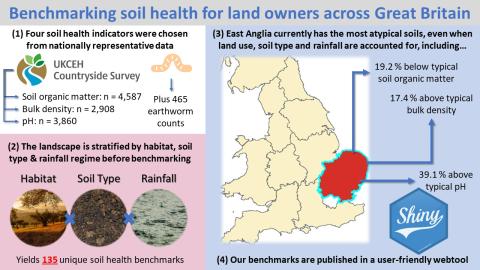Scientists at the UK Centre for Ecology & Hydrology (UKCEH) have created the first soil health benchmarks for soils in all landscape types, enabling a wider range of land managers than ever before to assess the status of their own soil. This new research, carried out as part of UK-SCAPE, was published in Science of the Total Environment on 8 May 2023.
Recognising the risks to our soils from intensive management, pollution and climate change, these benchmarks will allow for a much more complete assessment of the status of soil health across the country.
Soils are diverse and sensitive to factors such as land use, underlying geology and climate. Therefore, benchmarks were generated after first dividing Britain’s landscape up by habitat classes, soil types, and where possible, rainfall regimes. This ultimately produced 135 soil health benchmarks.
Unlike previous benchmarks for soil health, this is the first to consider the health of soils within the wider semi-natural landscape of grasslands, woodlands and wetlands, as well as agriculture across Great Britain.
To ensure the benchmarks are robust and not biased towards specific geographic regions or types of land managers, data from a long term, nationally representative monitoring programme, the UKCEH Countryside Survey, has been used to create them.

Key properties have been selected as an initial suite of soil health indicators, including:
• soil organic matter (as a measure of carbon storage primarily)
• pH (which regulates nutrient availability)
• bulk density (to indicate how compacted a soil is).
This takes advantage of the wealth of data amassed by decades of Countryside Survey, and highlights just how important it is to keep these long-term national-scale monitoring programs going.
• A fourth indicator of earthworm abundance (as a measure of biological activity) has also been selected using more unstructured data from the published literature.
Incorporating the benchmarks in a new webtool, launched last December, means landowners can assess the health of their soil against where it sits within the national picture. The benchmarks will help them to track progress of any changes to their management practices to improve soil health.
As well as allowing land managers to benchmark their soils, the data can also be used to explore which parts of the country currently hold the most atypical soils. Using data from the two most recent Countryside Survey campaigns (2007 and the ongoing 2019-23 surveys) revealed that East Anglia has the highest proportion of soils with very low soil organic matter, high pH, and high bulk density.
We might expect these results, given the large presence of arable land and drained organic soils in this region. However, the fact that so many soils here show atypical health characteristics compared to similar landscapes nationwide shows just how prominently East Anglian soils stand out.
This raises two important questions for scientists, policy makers and land managers to address:
1. To what extent are East Anglia’s soils vulnerable to degradation?
2. Should existing land management practices be modified here to improve soil health?
The new soil health benchmarking framework will hopefully be scaled up across Europe as part of the AI4SoilHealth project.
For further information and to access the benchmarking tool visit connect-apps.ceh.ac.uk/soilhealth
The open access paper is available on the Science of the Total Environment website.